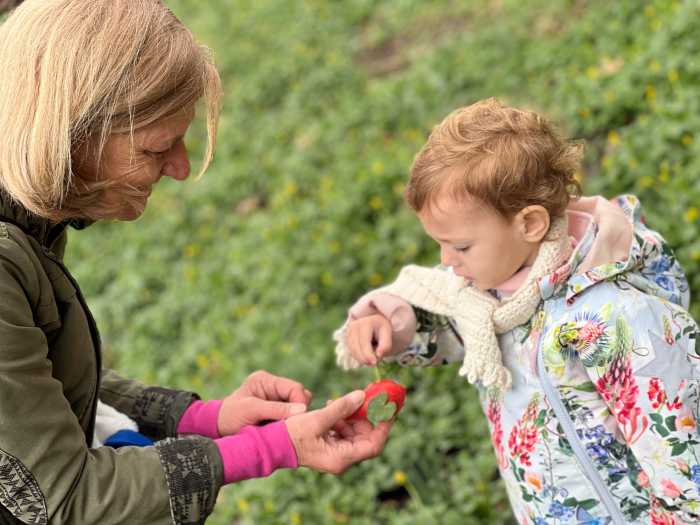
A soil sample / photo by Franziska Landes
Oct. 11, 2017 By Nathaly Pesantez
About 85 percent of soil samples collected from Greenpoint backyards indicate lead levels higher than the EPA’s safety standards, according to preliminary findings from a Columbia University doctoral student’s study.
With 264 samples pulled from 52 private Greenpoint backyards in a study done over the summer, 84 percent of the samples exceeded the Environmental Protection Agency’s recommended level of 400 parts per million for residential backyards. That means 92 percent of the backyards, 49 of the 52, had at least one soil sample with lead levels above the EPA’s suggested marker.
Five or six samples were taken from each backyard and analyzed by Franziska Landes, a doctoral candidate at Columbia University’s department of Earth and Environmental Sciences, and her assistant, Sabina Gilioli. Landes began systematically studying soil samples from the backyards of Greenpoint volunteers back in July, and wrapped up an analysis of the findings toward the end of September.

Franziska Landes collecting samples / photo by Franziska Landes
Landes explained that the EPA set up a hazard standard of 400 p.p.m. for bare soil that children can play in before being deemed unsafe and needing some type of remediation. The EPA also identified another value for non-play area soils —1,200 p.p.m—a number Landes was fixated on, as a whopping 35 percent of backyard soil samples showed lead levels in excess of 1,200 p.p.m., a level that also exceeds commercial standards laid out by the New York Department of Environmental Protection.
By the state’s standard of 1,000 p.p.m. for commercial use, 62 percent of the Greenpoint backyards tested had at least one soil sample that went above not just levels deemed unsafe for children to play in, but exceeded numbers deemed unsafe for industrial uses.
“I wasn’t necessarily surprised that some yards were just above 400,” Landes said, noting that the standards laid out by the EPA are merely guidelines, and not enforceable. “I was very surprised by the finding that one-third of backyard samples went above 1,200.”

Charts showing levels of lead in private yard samples compared to publicly collected samples
The impetus for the research, according to Landes, came about as a continuation of efforts by Brooklyn College and the local Neighbors Allied for Good Growth (NAG) to measure and analyze lead levels in the neighborhood’s soil. NAG already began a push for residents to measure lead in their backyards prior to the summer research, and was largely responsible for advertising the study to Greenpoint volunteers.
Because most of the volunteers were aware of the historically high levels of lead in the area, and already had an inkling that lead levels in their backyards must be at high numbers, participants kept their astonishment at the findings mostly at bay.
“The history of the neighborhood is very industrial,” said Alan Minor, NAG chair. “Combine that with old buildings built with toxic materials, the fact that there is the BQE that was put through the neighborhood–when you think about that it’s not surprising.”
A 2015 study by the NYC Department of Health, for instance, shows Greenpoint children more likely to have elevated levels of lead in their blood compared to children citywide. A 2012 DOH report shows that Greenpoint children are four times more likely to have lead poisoning than the citywide standard.
NAG also took over 100 community based soil samples over the course of late 2016 and early 2017, and saw overall high levels of lead from privately owned spaces.
“I love that we have some numbers,” said Lisa Bloodgood, a board member for NAG. “I think it’s so helpful and I’ve wanted to see the health department address this in a more comprehensive way. When we are informed, we can do much better.”
Councilmember Stephen Levin said the findings are deeply concerning in a statement, and noted that he will be working with the Department of Health to coordinate a more comprehensive campaign to address the issue all-too-familiar in an area that has been historically challenged by pollutants. “I’m grateful of the dedicated individuals working to understand the scope of the problem. We have to build on their efforts and go one step further.”
The next part of Landes study will focus on why the neighborhood has such high numbers, including an exploration on Greenpoint’s industrial history, a goal that NAG has also set for itself. Her research will also try to determine why the gap between lead levels in soil from public places and private backyards is so wide. Overall, the research done in Greenpoint is part of her thesis where she is figuring out improved ways to measure for lead and reduce lead exposure.
In the meantime, Landes is spreading the word to volunteers on how to prevent contamination and implement lead remediation techniques. Against the backdrop of potentially severe problems in children brought on lead poisoning, including lowered IQ, behavioral and learning problems, and anemia, relatively simple practices, like washing hands after gardening and helping children avoid touching their mouths after playing in the garden, can help reduce lead exposure.
Bloodgood recommends that concerned residents get their soil tested for a small fee.
“If you’re living in an urban environment or if your area has an industrial history, or your house was built before 1970, it’s important to test your soil,” Landes said. “Especially if you have children.”
One Comment






Our daughter just moved into an apartment in Greenpoint with a backyard. Who can she contact to get her soil tested? Thank you.